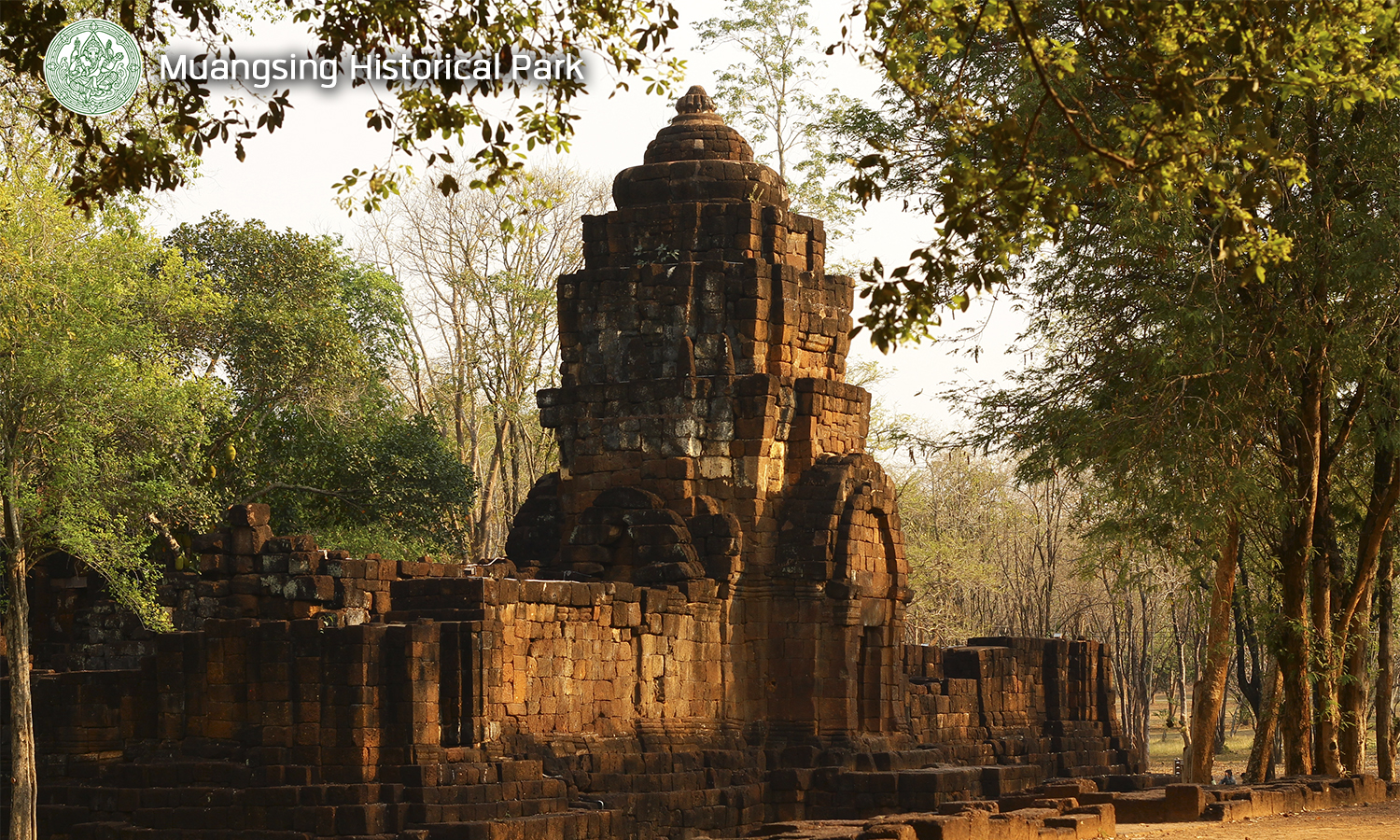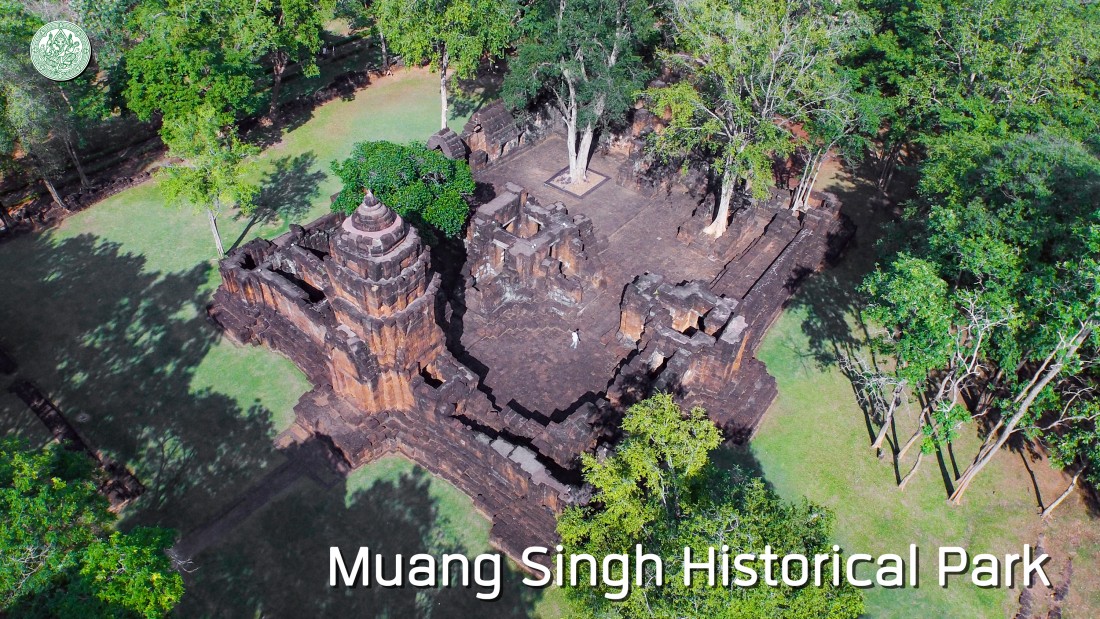| Muang Singh Historical Park |
| Muang Singh Historical Park is located at Khwae Noi riverside in Tambon Muang Singh, Amphoe Sai Yok, Kanchanaburi Province with the areas of 641 Rai, 1 Ngaan, 65 Tarangwa (1.02626 square kilometers) include Muang Singh and Prasat Muang Singh. It is the ancient city located at Khwae Noi river basin which is an abundant area. Therefore, it has a human settlement since prehistoric age and also the cultural development that has been continued till the history period as found many archaeological evidences both prehistoric age and history period. These archaeological evidences have reflected a part of human civilization which had a role in the territory of Kanchanaburi Province likes human skeleton, tool, and instrument of prehistoric age that can be defined age around 2,000 years ago. They were found at the northern area of Muang Singh which adjoin Khwae Noi River and also the evidence of history period which is the timeline of Muang Singh construction. For instances, having an urban plan as a square-shaped, constructing the religious place likes Prasat Muang Singh at the city center or discovering Khmer Art sculptures of Bayon Period in many designs. According to the value and importance of this place, the Fine Arts Department has announced the registration of Muang Singh and Prasat Muang Singh to be a national historical site in the Government Gazette, 52nd volume, 75th part, on 8th March 2478. Anyhow, the Fine Arts Department has developed Muang Singh and Prasat Muang Singh since 2517 to 2519 B.E. Then, it has created as the Development Project of Prasat Muang Singh Historical Site and offered to assign in The Fourth National Economic and Social Development Plan (2520-2524) and The Fifth National Economic and Social Development Plan (2525-2529). Therefore, the name was changed to Muang Singh Historical Park Project. In addition, the Fine Arts Department has operated the excavation and reconstruction until it is completed and also officially opened on 3rd April 2530 B.E., Her Royal Highness Princess Maha Chakri Sirindhorn proceeded to preside at the opening ceremony. |
| Information of Muang Singh and Prasat Muang Singh |
| Human Development in Thailand has existed for a long time over ten thousand years since prehistoric age to history period as found the evidence which confirmed about many archaic human existences in Thailand. Some of evidences were found in the western of Thailand, especially at the areas of two river basins likes Khwae Noi and Khwae Yai. In this point will mention about the Human Development at Khwae Noi river basin area which has the history relevant to Muang Singh and Prasat Muang Singh. Khwae Noi River consists in a mountain stream in the area of Amphoe Sangkhla Buri, Kanchanaburi Province and Lam Pachee River that flowed from Tanaosri mountain range in Amphoe Chom Bung, Rachaburi Province. This river long about 230 kilometers and confluent flowed with Khwae Yai River at Tambon Pak phreak, Kanchanaburi Province and became to Mae Klong River. |
| The inscription evidence of Prasat Muang Singh |
| According to Prasat Preah Khan Inscription found at Phra Nakhon City of Cambodia, it has mentioned that King Chai Varaman VII of Khmer Empire has enshrined the model of Jaya Buddha Mahanart in the religious place of the 23 cities. Among these city names, it is believed that the 6 cities are located in Central Thailand at present because found the antiques of Khmer Art that is contemporary with King Chai Varaman VII Period. There is one of these cities which assumed that it was the location of Prasat Muang Singh likes Sri Chai Sing Buri city because apart from the name is coincident with the city name that appeared in the inscription, this Prasat also has the architectural and sculptural designs as Khmer Style. In Bayon Period which supported that Prasat Muang Singh probably built in the reign of King Chai Varaman VII. Meanwhile, many academicians argued with this idea by claiming that Muang Singh is the name which only called in Rattanakosin Period. It can be assumed that the name “Sri Chai Sing Buri” is more likely to be Sing Buri Province because able to verify that it is the old name of Sing Buri Province in the early Ayutthaya Period. In Sing Buri Province hasn’t found the evidences or antiquities that relevant to Bayon Khmer Art. The issue that Prasat Muang Singh will be the same place with Sri Chai Sing Buri according to the academician belief or not, it is the issue that still hasn’t found the conclusion. It is necessary to find another archaeological evidence to more support, especially the archaeological evidence that have to increasingly excavated at the inside of Muang Singh. Apart from an excavation of four historical sites and graves of prehistoric age, also has a document which has mentioned to Prasat Muang Singh that Muang Singh was built in the period which Khmer Empire dominated over this realm and originally was not the quite large city because found the small historical site. When the city of Central Thailand dominated the realm in this side represents the Khmer Empire which has declined, especially in Ayutthaya Period, the king who governed the city would has a royal idea that Muang Singh is a small city not important. Therefore, he hasn’t designated a governor for the city. In addition, Tam Neab Sakdina Hua Muang has not appeared the name of Muang Singh as understand that when Khmer Empire was declined, Muang Singh and Prasat Muang Singh were abandoned as an unoccupied town. |
| The inscription evidence found at Prasat Muang Singh |
| According to a discovery of sculpture pedestal at the area of the historical site number 2 which has the short text pronounced that “Phraya Chaiyakorn”, it can be assumed that it is the name of creator, person sculpture, and portrait of Prasat-owner or the Prasat Muang Singh creator, but unfortunately, this sculpture has already disappeared. When studied the alphabet design, it can be seen that this inscription was engraved with Khmer Alphabet. It look likes the alphabet in Dong Mae Nang Muang Inscription and the inscription at the backside of Buddha Sheltered by Naga Hood. As the comparison, it can be seen that the alphabet in this inscription is unique with a local design which different from the alphabet in the group of Ratchathani. A part which is distinctly observed likes the configuration of alphabet, it similar to the alphabet that appeared in the inscription group of infirmary or Arokaya Sarn which built in the reign of King Chai Varaman VII of Khmer Empire during the 18th century Buddha. The alphabet design of Muang Singh was changed to be different from the alphabet of Khmer Empire. |
| The evidence from historical document |
| Apart from the inscription found at Prasat Muang Singh, it hasn’t found any evidence about Prasat Muang Singh again until the reign of King Phutthayotfa Chulalok (Rama I) of Rattanakosin. He established Muang Singh again as a small border town which governed by governor and depend on Kanchanaburi Province. Because this area is backcountry, the governor did not settle down here, but they set their house at Ban Pong instead and sent a patrolling to monitor regularly. The governor will go to command just occasionally when an emergency occurred. Then, in the reign of King Chom Klao Chao Yu Hua (Rama IV), he bestowed the names to the governors who governed the city along Khwae Noi River, the name “Phra Nikhota Phiyok” to Sai City Governor, the name “Phra Shin Ditta Bodhi” to Takua Pa Governor and the name “Phra Saming Singha Burin” to Muang Singh Governor. Muang Singh had stayed in a position as border town until the reign of King Chulalongkorn (Rama V), he changed the administration and established to the “Monthon thesapiban” administration. Therefore, Muang Singh was downgraded to Tambon called Tambon Muang Singh until the present. |
|
| Architectural and Sculptural Evidences of Prasat Muang Singh |
Originally, a study of background and age of Prasat Muang Singh construction will focus only the historical site number 1. Base on the Mahayana Buddhism icon sculpture which only found in the area of Prasat Muang Singh. The comparison with Khmer Art design which has been already defined age, the study can be concluded that the historical site is Bayon Khmer Art around the 18th century Buddha which corresponding to the reign of King Chai Varaman VII of Khmer Empire that spread an influence to Thailand. At present, there is an additional study from the historical site number 2, rampart, moat and mound, some sculptural icon even decorating stucco pattern of the Prasat. It looks like to be consistent, but in fact there is some problem as while the sculptural icon is Bayon Khmer art, the Prasat includes the stucco pattern is an imitation that the local craftsman was not proficient about this architecture, each Prang was unbalanced construction. Therefore, it has a reformation by apply a concrete to transform the Prang, but not all can be reformed. As can be seen from the unequal indented-corner of the door and each Prang is not straight also. This condition will not appear in the real Khmer architecture although it is more larger than. According to this evidence, it established a new concept that the historical sites inside of Prasat Muang Singh are unlikely to be the contemporary art with Bayon Khmer style or King Chai Varaman VII Period. After Khmer Empire was declined around the late of 18th - 19th century Buddha. In this period has a gathering of the city in this area as a region to compete an empowerment to replace the declined Khmer Empire. Some of the cities used Theravada Buddhist Principles to enhance a strength as can be seen from an endeavor of Sukhothai during the late 19th century Buddha to the early 20th century Buddha in the reign of King Maha Thammaracha I (Li Thai) or Ayutthaya Period that attempted to inherit Khmer belief and blend with Theravada Buddhist Principles. According to the principle, it can be defined age the construction of Muang Singh and religious place inside that it probably build in a turning point which Khmer Empire was declined and the time of empowerment of the cities in this area. It brought Khmer architectural pattern to imitate, as can be seen from Khmer architecture which built by local craftsman in many areas, such as the Prang of Wat Mahathat, Ratchaburi Province or the Prang of Wat Mahathat, Lopburi Province, etc. At the historical site number 2 of Muang Singh which showed about an ineptitude of creation of the local craftsman causes it has to rebuilt likes the historical site number 1 or Prasat Muang Singh. For the sculptural icon found at Prasat Muang Singh or another place which is proficiency of real Khmer craftsman, it can be expected that is a sculpture from Cambodia. After Khmer Empire was declined, may be caused by Khmer priest. Although it has the concept about the background which has some difference be it age or persistence of Muang Singh, this concept can be concluded about the age of construction which is quite different as Muang Singh and the historical site inside that built around the 18th – 19th century Buddha or about 800 years ago. It is also the city which built as Khmer Principles that always build the religious place at city center. The architectural and sculptural designs that found are similar design with the Khmer Art by King Chai Varaman VII Period, but blending with local art. It is the historical site in Mahayana Buddhism. The important icon such as Bodhisattva Avalokitesvara, Buddha Sheltered by Naga's Hood, and Female god Pratchaya-Paramita which three of them are called Buddhistic Triad.
|














